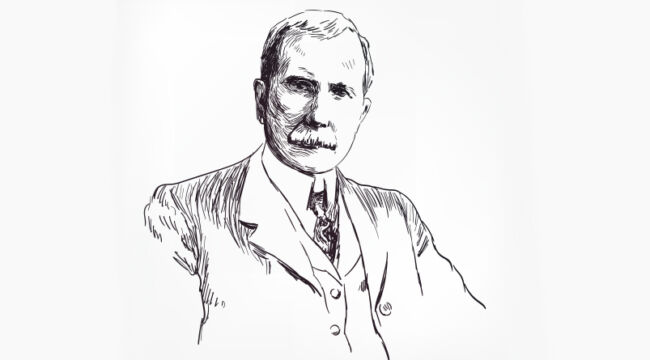Rockefeller’s Legacy for The New American System
“I always tried to turn every disaster into an opportunity,” said John D. Rockefeller, one of the wealthiest Americans in history. The late 1800s was a time of high tariff barriers, flourishing American industry, low regulations, and booming trade within our borders. It was part of the historical American System that Jim described in the recent Strategic Intelligence issue.
The American System refers to a period featuring high tariffs, increased infrastructure investment, strong defense, and a central bank with limited powers.
This environment was ideal for a ruthless competitor like Rockefeller. President Trump would approvingly call Rockefeller a “killer” – a man you would never want to cross in competition.
Rockefeller’s journey into the oil industry began in 1863 when he, along with Samuel Andrews and Samuel Clark, formed Andrews, Clark & Company. But it was the creation of Standard Oil in 1870 with his brother William, Henry Flagler, and Stephen Harkness that truly marked the beginning of his ascendancy.
Building a Monopoly
One crucial moment in Rockefeller’s rise was his decision to acquire several refineries. In what is known as the “Cleveland Massacre,” Rockefeller and Flagler bought 22 out of 26 refineries in Cleveland over just six weeks in early 1872. This aggressive acquisition was part of a plan to consolidate the oil refining industry under Standard Oil’s control.
Rockefeller’s strategy was to cut waste and produce high-quality products at low prices. Unlike other refiners who wasted byproducts like gasoline, Rockefeller’s team developed over 300 byproducts from each barrel of crude oil, including lubricating oils, paraffin, and benzene. This approach reduced waste and created new revenue streams.
To further his mission, Rockefeller made secret deals with major railroads. He negotiated reduced transportation rates and rebates, giving Standard Oil a significant advantage over its competitors. For example, through a deal with the South Improvement Company, Rockefeller secured a rate of $2.56 per barrel from Cleveland to New York but received a $1.06 rebate. The railroads also paid him $1.06 per barrel for oil not produced by Standard Oil.
The South Improvement Company was critical to Rockefeller’s plan to control the oil market. Although the company never shipped any oil, it caused widespread outrage due to its favorable treatment by railroads and its aim to limit oil production. The public backlash became so intense that the Pennsylvania legislature repealed the company’s charter in April 1872, before it could conduct any transactions.
Despite the failure of the South Improvement Company, Rockefeller continued his aggressive expansion. He used the threat of financial ruin to pressure smaller refineries to sell out. If they resisted, he would show them his company’s financial records. This usually convinced competitors to sell at what he deemed the market value of their assets. Often, this value was lower than what the owners believed their companies were worth. To be fair to Rockefeller, those who took shares of Standard Oil in buyout deals did very well. As you’ll see in a few moments, shareholders of refinery company Tesoro, who elected to take shares of this month’s recommendation in 2018, have done very well.
Rockefeller’s methods were ruthless but effective. By the end of 1872, Standard Oil controlled nearly a third of the U.S. refining capacity, up from just 10% before the Cleveland Massacre. He closed down inefficient refineries, regulated production to match market demand, and began developing pipelines to reduce dependence on railroads.
Ruthless Capitalism
The impact of Rockefeller’s actions was profound for his company… and his army of happy customers. The Cleveland Massacre marked the beginning of Standard Oil’s dominance in the oil industry. By the 1880s, Standard Oil controlled 80% of the North American oil market. Rockefeller’s focus on efficiency and innovation transformed the industry.
Although his methods sparked bad press coverage and legal challenges for monopolistic practices, the downstream benefits of cheaper, standardized refined products were incalculably large. It sparked the biggest supply-side boom in U.S. history:
- Manufacturers, using refined fuels, got a cost advantage over European rivals by the late 1800s.
- Tanker-hauling railroads got more revenue from a large customer, which in turn allowed them to haul for other, smaller customers at lower prices.
- Kerosene lamps allowed for studying and production to continue in the dark.
- Even environmentalists would have to admit that Rockefeller “saved the whales” from overfishing for the lamp oil markets. Standard Oil’s kerosene was much cheaper for lamps. Kerosene only got that cheap because Rockefeller focused so intently on building larger-scale operations so unit costs could be driven lower and lower.
Was Rockefeller a scoundrel or a hero? It depends on your perspective. Competitors hated him. Customers loved him. Also, a devout Christian, he would have detested the many dark initiatives funded by heirs at the Rockefeller Foundation. In the end, Rockefeller’s legacy is thoroughly American: a mix of innovation, efficiency, sharp-elbowed competition, and ambition.



Comments: